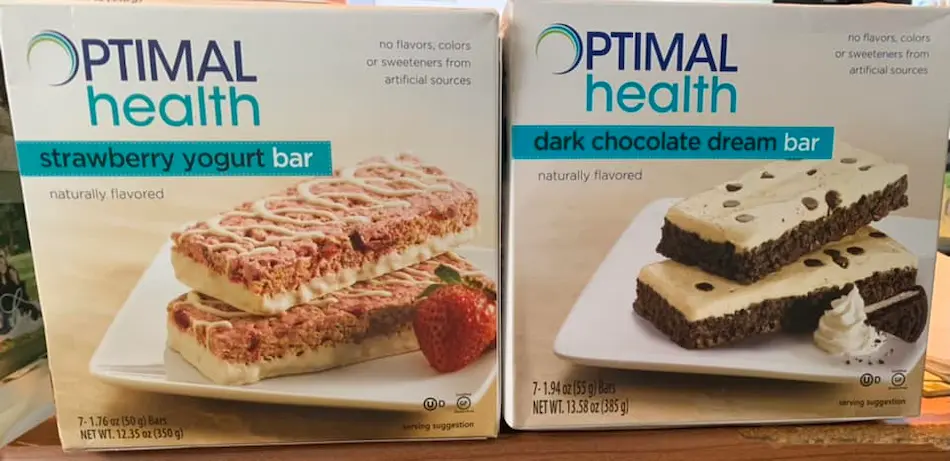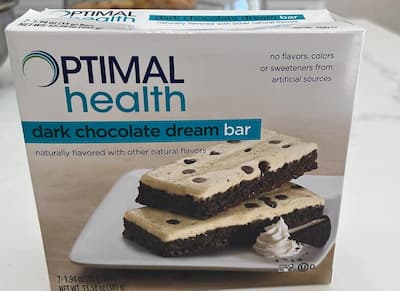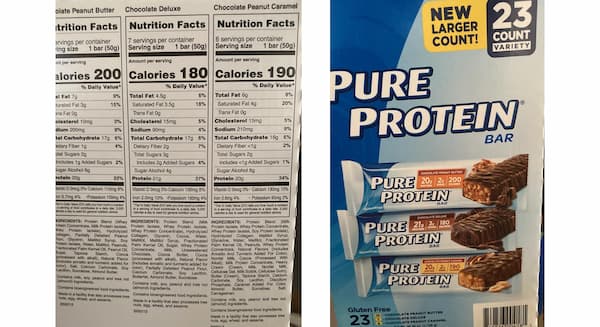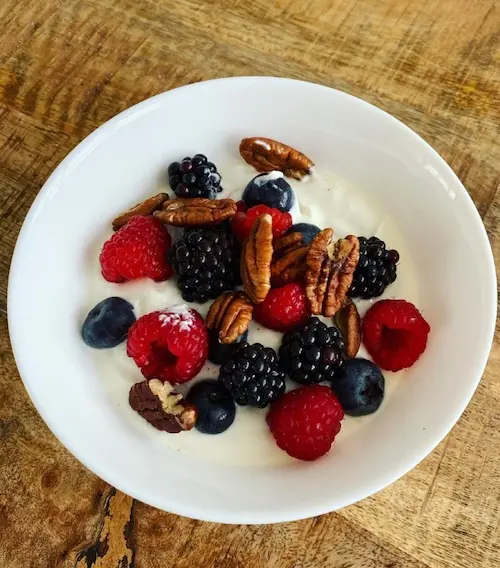
Optavia 3 and 3 plan refers to the last part of the Optavia weight loss program. The goal of Optavia 3 and 3 is weight management and preventing weight regain.
Unlike the 5 and 1 plan from Optavia which focuses on weight loss, the Optimal Health 3 and 3 plan is tailored to sustaining your goals.
This weight maintenance plan encourages you to eat three meals per day (breakfast, lunch, dinner), while adding three Optavia fuelings throughout your day.
Although you will likely be eating more calories, moving more frequently, and preparing home-cooked meals from scratch, everything is portion-controlled to help you keep track of calorie intake.
What is the Optavia 3 and 3 plan?
The Optavia 3 and 3 is the final step of the Optavia 5 and 1 plan.
After you have achieved your desired weight and concluded a 6-week transition phase, it’s time to enter the maintenance phase with this program.
What makes this program special is that not only can you increase your calorie intake, but your options for food selections also increase.
What’s more, you’ll be basing how much food (and thus how many calories) you eat on your total energy expenditure (TEE).
Optavia 3 and 3 TEE
According to the Sports Medicine Journal, “Total energy expenditure (TEE) is the amount of energy a person uses in one day.”
It has three parts:
- Basal metabolic rate (BMR), is the energy used for basic body functions when resting
- Exercise activity thermogenesis (EAT), is the energy used for physical activity; and
- The thermic effect of food (TEF), is the energy used to digest food.
You may be surprised to find out how important TEE is in helping maintain a steady, healthy lifestyle.
With that being said, this stage of the Optavia plan is a critical component for long-term success and should not be overlooked.
How Does Optavia 3 and 3 Plan Work?
The Optavia 3 & 3 Plan works by giving you the tools to sustain a healthy weight through common sense approaches. This weight management program involves three main steps: calculating your Total Energy Expenditure (TEE), building a meal plan, and following that meal plan.
1. Calculating your Total Energy Expenditure
The first step is to calculate your Total Energy Expenditure (TEE).
This will allow you to determine how many calories you need to be consuming per day in order to reach and maintain your diet goals.
Don’t forget that increasing your level of physical activity is also essential when trying to keep those excess pounds off, so make sure you are staying active as well!
2. Building a meal plan
The second step is to calculate how much food you can eat per day and build your Optavia 3 and 3 meal plan.
Knowing the exact number of daily calories for your body can help you build the most suitable diet for yourself.
Here, you can either create your own meal plan.
Or, if you’re short on time, you can rely on Optavia-approved sample plans developed by registered dietitians.
According to Optavia guidelines, Optimal Health 3 and 3 meal plans range from 1,200 – 2,500 calories.
3. Following a meal plan
Finally, I recommend you should know your Optavia 3 and 3 food list and serving sizes by heart.
This maintenance plan allows you to include food items like:
- Fruits: Fresh whole fruits like apples, oranges, and pearls, canned fruits, grapes, and bananas.
- Dairy: Cottage cheese, milk, and milk substitutes
- Starches: Whole grain bread, pitas, unsweetened breakfast cereals, and grains
- Proteins: Lean beef, poultry, sausages, and selected cheeses
- Fats: Oils, butter, avocados, and nuts
- Vegetables: All types of vegetables
Use Optavia healthy exchange list as your serving size guide, which includes a great variety of foods.
All of the food options are around 100 calories and under 15 carbohydrates.
Plus, you can include occasional alcoholic beverages, as well as free choice snacks from the healthy exchange list.
What Is The Cost of Optavia 3 and 3 Plan?
The cost of the Optavia 3 and 3 Plan is $283.05 per month. This price includes several components essential for the plan, such as 9 boxes of fuelings, 6 boxes of snacks, 1 box of flavor infusers, and 4 boxes of Lean and Green meals. In total, these provisions amount to 130 servings.
Unsurprisingly, the 3 and 3 plan is more affordable than the 5 and 1 plan becasue it includes eating 3 fuelings per day.
This means that you don’t have to commit to 5 fuelings each day, which quickly adds up over the weeks and months.
Here’s a photo of what the Optavia 3 and 3 dark chocolate dream bar box looks like.

A box of Optavia 3 and 3 fuelings costs $21.75, compared to $23.25 for essential fuelings.
Here’s what the Optavia drizzled chocolate fudge crisp bar from essential fueling looks like.

As you can imagine, this adds up over time since you need fewer boxes if using the 3 & 3 than if using a 5 & 1 plan.
While the price for the Optimal Weight 5 and 1 plan bundle retails at $395.25 (plus shipping), for the Optavia 3 and 3 plan you can expect to pay around $283 a month.
What Is the Recommended Calorie Intake in Optavia 3 and 3 Plan?
Following the Optavia 3 and 3 Plan means your total calorie intake for the week will be somewhere between 8,400 and 17,500 calories.
Optavia’s weight loss and maintenance plan have some key differences, most notably in their Fuelings. Fuelings may contain the same ingredients, but they have different macros and calories.
Optavia 5 and 1 Fuelings
- Calories: 100-110 per serving
- Total fat: 1 gram
- Total carbohydrates: 12 grams
- Fiber: 6 grams
- Added sugars: 5 grams
- Protein: 10 grams
Optavia 3 and 3 Fuelings
- Calories: 160-190 per serving
- Total fat: 3.5 grams
- Total carbohydrates: 22 grams
- Fiber: 4 grams
- Added sugars: 13 grams
- Protein: 15-18 grams
As you can see, Optavia health fuelings have nearly double the calories of essential fuelings.
In fact, the three servings of Optavia Health fuelings contain more calories than the five essential fuelings combined.
Plus, the calories in Optvaia 3 and 3 bars are strikingly similar to those in other protein bar brands like Pure Protein or Quest bars.
Although there are many differences between Optavia essential bars and quest bars, Optavia Health fuelings are almost identical.
Here’s the photo of Pure Protein bar nutrition facts.

These Pure Protein bars have 180-200 caloires, 20 grams of protein, and 17 grams of carbohydrates.
(I would also imagine they are a bit less expensive.)
Optavia 3 and 3 meal plans
Meal plans may seem intimidating to figure out, but with the help of calculating your TEE and following a meal plan based on your caloric requirements, it’s actually quite straightforward.
With Optavia 3 & 3 Plan, you can determine how many starches, dairy products, proteins, vegetables, fruits, and fats you should consume each day.
And no need to use complicated mathematics as the table below explains exactly how much of each food group servings you can eat according to your daily calorie allowance.
| Calories | Starches | Dairy | Proteins | Vegetables | Fruits | Fats |
|---|---|---|---|---|---|---|
| 1,200 kcal | 1 | 2 | 2 | 3 | 1 | 1 |
| 1,300 kcal | 1 | 2 | 2 | 3 | 1 | 1 |
| 1,400 kcal | 1 | 2 | 2 | 3 | 2 | 2 |
| 1,500 kcal | 2 | 2 | 2 | 3 | 2 | 2 |
| 1,600 kcal | 2 | 2 | 2 | 3 | 2 | 2 |
| 1,700 kcal | 2 | 3 | 2 | 3 | 2 | 2 |
| 1,800 kcal | 2 | 3 | 2 | 3 | 3 | 3 |
| 1,900 kcal | 2 | 3 | 2 | 3 | 3 | 3 |
| 2,000 kcal | 3 | 3 | 2 | 4 | 3 | 3 |
| 2,100 kcal | 3 | 3 | 2 | 4 | 3 | 3 |
| 2,200 kcal | 3 | 3 | 2 | 4 | 3 | 4 |
| 2,300 kcal | 3 | 3 | 2 | 4 | 4 | 4 |
| 2,400 kcal | 3 | 4 | 2 | 4 | 4 | 4 |
| 2,500 kcal | 4 | 4 | 2 | 4 | 4 | 5 |
Optavia 2,000 calorie sample meal plan
Breakfast
Breakfast is easy. Most of the Optavia 3 and 3 breakfasts include one serving size of starch, dairy, and fruit.
Here’s what an Optavia 3 and 3 breakfast looks like.

- Starch one serving: 3/4 cup of ready-to-eat unsweetened cereal
- Dairy one serving: 1 cup skim milk
- Fruit one serving: 1 and 1/4 cup whole strawberries
Only the 2,400-calorie and 2,500-calorie meal plans include 2 dairies and 2 dairies and 1 extra fat, respectively.
Mid-morning fueling
Here you can choose any Optavia fueling from the Optimal Health list.
Lunch
For lunch, the number of servings of each food group you can have will vary depending on your TEE.
- Starch one serving: 1 slice of whole-wheat bread
- Dairy one serving: 3/4 cup low-fat yogurt
- Protein one serving: 6 oz. grilled chicken
- Vegetable two servings: 2 cups raw spinach, 1 cup total diced tomatoes, cucumbers, and mushrooms
- Fruits one serving: 1 small apple
- Fats one serving: 1 tsp olive oil
Mid-afternoon fueling
Here you can choose any Optavia bar or shake from the Optimal Health list.
Dinner
Unless you have different preferences, dinner is usually your biggest meal of the day.
- Starch one serving: 1/2 cup baked sweet potato
- Dairy one serving: 1 cup of low-fat milk
- Protein one serving: 6 oz. baked yellowfin tuna
- Vegetable two servings: 1 cup total cooked cauliflower and broccoli
- Fruits one serving: 1 cup canned sliced pears
- Fats two servings: 2 tsp olive oil
Evening fueling
Here you can choose any Optavia bar or shake from the Optimal Health list.
Free choice
Enjoy the occasional treat of an alcoholic beverage, or snack smartly with one free choice item from Optavia’s healthy exchanges.
Can you lose weight on Optavia 3 and 3?
Surprisingly, you can, as long as you stay physically active.
Although Optavia 3 and 3 plan is designed as a weight maintenance program, you still can lose weight if you increase your daily energy expenditure.
You can do that by either adding more purposeful exercise or by increasing your NEAT (Non-exercise activity thermogenesis).
Another way to lose weight while doing Optavia 3 and 3 maintenance is by doing body recomposition via strength training.
It involves eating calories at your maintenance level while slowly working to build muscle mass, therefore, gently improving body composition.
According to the article published in the Strength and Conditioning Journal, “body recomposition happens a lot in people who are new to working out and people who are overweight.”
Usually, people trying to lose fat are told to eat less food (a calorie deficit), and people trying to gain muscle are told to eat more food (a calorie surplus).
“Although this is what most people do, there is evidence that suggests there may be better ways to improve body composition,” states the journal.
For example, there is data showing that “people can gain muscle and lose fat at the same time by eating more food (a calorie surplus). We don’t yet understand why this happens or how it works,” states the article.
So, is Optavia 3 & 3 the right fit for you?
For me, the Optavia 3 & 3 plan can be a decent option, as it is focused on maintaining your results over time.
But keep in mind that it still requires meeting with coaches and purchasing pricey snacks and meals alongside traditional lean and green items.
All in all, no single step-by-step model will work perfectly for everyone.
Before starting any type of diet or fitness plan, consult with your physician or healthcare provider to determine what will be the most effective approach.
